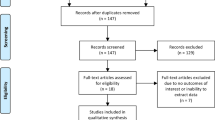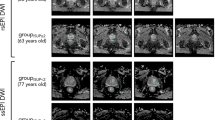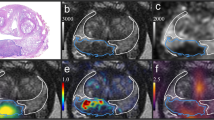Abstract
Background:
Multiparametric magnetic resonance imaging (mp-MRI) is increasingly advocated for prostate cancer detection. There are limited reports of its use in the setting of radiorecurrent disease. Our aim was to assess mp-MRI for detection of radiorecurrent prostate cancer and examine the added value of its functional sequences.
Methods:
Thirty-seven men with mean age of 69.7 (interquartile range, 66–74) with biochemical failure after external beam radiotherapy underwent mp-MRI (T2-weighted, high b-value, multi-b-value apparent diffusion coefficient (ADC) and dynamic contrast-enhanced (DCE) imaging); then transperineal systematic template prostate mapping (TPM) biopsy. Using a locked sequential read paradigm (with the sequence order above), two experienced radiologists independently reported mp-MRI studies using score 1–5. Radiologist scores were matched with TPM histopathology at the hemigland level (n=74). Accuracy statistics were derived for each reader. Interobserver agreement was evaluated using kappa statistics.
Results:
Receiver–operator characteristic area under curve (AUC) for readers 1 and 2 increased from 0.67 (95% confidence interval (CI), 0.55–0.80) to 0.80 (95% CI, 0.69–0.91) and from 0.67 (95% CI, 0.55–0.80) to 0.84 (95% CI, 0.76–0.93), respectively, between T2-weighted imaging alone and full mp-MRI reads. Addition of ADC maps and DCE imaging to the examination did not significantly improve AUC for either reader (P=0.08 and 0.47 after adding ADC, P=0.90 and 0.27 after adding DCE imaging) compared with T2+high b-value review. Inter-reader agreement increased from k=0.39 to k=0.65 between T2 and full mp-MRI review.
Conclusions:
mp-MRI can detect radiorecurrent prostate cancer. The optimal examination included T2-weighted imaging and high b-value DWI; adding ADC maps and DCE imaging did not significantly improve the diagnostic accuracy.
This is a preview of subscription content, access via your institution
Access options
Subscribe to this journal
Receive 4 print issues and online access
$259.00 per year
only $64.75 per issue
Buy this article
- Purchase on Springer Link
- Instant access to full article PDF
Prices may be subject to local taxes which are calculated during checkout



Similar content being viewed by others
References
Kara T, Akata D, Akyol F, Karcaaltincaba M, Ozmen M . The value of dynamic contrast-enhanced MRI in the detection of recurrent prostate cancer after external beam radiotherapy: correlation with transrectal ultrasound and pathological findings. Diagn Interv Radiol 2011; 17: 38–43.
Roach M 3rd, Hanks G, Thames H Jr., Schellhammer P, Shipley WU, Sokol GH et al. Defining biochemical failure following radiotherapy with or without hormonal therapy in men with clinically localized prostate cancer: recommendations of the RTOG-ASTRO Phoenix Consensus Conference. Int J Radiat Oncol Biol Phys 2006; 65: 965–974.
Consensus statement: guidelines for PSA following radiation therapy. American Society for Therapeutic Radiology and Oncology Consensus Panel. Int J Radiat Oncol Biol Phys 1997; 37: 1035–1041.
Denham JW, Kumar M, Gleeson PS, Lamb DS, Joseph D, Atkinson C et al. Recognizing false biochemical failure calls after radiation with or without neo-adjuvant androgen deprivation for prostate cancer. Int J Radiat Oncol Biol Phys 2009; 74: 404–411.
Pickles T . Prostate-specific antigen (PSA) bounce and other fluctuations: which biochemical relapse definition is least prone to PSA false calls? An analysis of 2030 men treated for prostate cancer with external beam or brachytherapy with or without adjuvant androgen deprivation therapy. Int J Radiat Oncol Biol Phys 2006; 64: 1355–1359.
Ornstein DK, Oh J, Herschman JD, Andriole GL . Evaluation and management of the man who has failed primary curative therapy for prostate cancer. Urol Clin North Am 1998; 25: 591–601.
Westphalen AC, Kurhanewicz J, Cunha RM, Hsu IC, Kornak J, Zhao S et al. T2-weighted endorectal magnetic resonance imaging of prostate cancer after external beam radiation therapy. Int Braz J Urol 2009; 35: 171–180; discussion 181-172.
Morgan VA, Riches SF, Giles S, Dearnaley D, deSouza NM . Diffusion-weighted MRI for locally recurrent prostate cancer after external beam radiotherapy. AJR Am J Roentgenol 2012; 198: 596–602.
Westphalen AC, Coakley FV, Roach M 3rd, McCulloch CE, Kurhanewicz J . Locally recurrent prostate cancer after external beam radiation therapy: diagnostic performance of 1.5-T endorectal MR imaging and MR spectroscopic imaging for detection. Radiology 2010; 256: 485–492.
Kim CK, Park BK, Lee HM . Prediction of locally recurrent prostate cancer after radiation therapy: incremental value of 3T diffusion-weighted MRI. J Magn Reson Imaging 2009; 29: 391–397.
Haider MA, Chung P, Sweet J, Toi A, Jhaveri K, Menard C et al. Dynamic contrast-enhanced magnetic resonance imaging for localization of recurrent prostate cancer after external beam radiotherapy. Int J Radiat Oncol Biol Phys 2008; 70: 425–430.
Westphalen AC, Reed GD, Vinh PP, Sotto C, Vigneron DB, Kurhanewicz J . Multiparametric 3T endorectal MRI after external beam radiation therapy for prostate cancer. J Magn Reson Imaging 2012; 36: 430–437.
Akin O, Gultekin DH, Vargas HA, Zheng J, Moskowitz C, Pei X et al. Incremental value of diffusion weighted and dynamic contrast enhanced MRI in the detection of locally recurrent prostate cancer after radiation treatment: preliminary results. Eur Radiol 2011; 21: 1970–1978.
Arumainayagam N, Ahmed HU, Moore CM, Freeman A, Allen C, Sohaib SA et al. Multiparametric MR imaging for detection of clinically significant prostate cancer: a validation cohort study with transperineal template prostate mapping as the reference standard. Radiology 2013; 268: 761–769.
Donati OF, Jung SI, Vargas HA, Gultekin DH, Zheng J, Moskowitz CS et al. Multiparametric prostate MR imaging with T2-weighted, diffusion-weighted, and dynamic contrast-enhanced sequences: are all pulse sequences necessary to detect locally recurrent prostate cancer after radiation therapy? Radiology 2013; 268: 440–450.
Kumbhani SR, Coakley FV, McCulloch CE, Wang ZJ, Kurhanewicz J, Roach M 3rd et al. Endorectal MRI after radiation therapy: questioning the sextant analysis. J Magn Reson Imaging 2011; 33: 1086–1090.
Kim CK, Park BK, Park W, Kim SS . Prostate MR imaging at 3T using a phased-arrayed coil in predicting locally recurrent prostate cancer after radiation therapy: preliminary experience. Abdom Imaging 2010; 35: 246–252.
Arumainayagam N, Kumaar S, Ahmed HU, Moore CM, Payne H, Freeman A et al. Accuracy of multiparametric magnetic resonance imaging in detecting recurrent prostate cancer after radiotherapy. BJU Int 2010; 106: 991–997.
Tamada T, Sone T, Jo Y, Hiratsuka J, Higaki A, Higashi H et al. Locally recurrent prostate cancer after high-dose-rate brachytherapy: the value of diffusion-weighted imaging, dynamic contrast-enhanced MRI, and T2-weighted imaging in localizing tumors. AJR Am J Roentgenol 2011; 197: 408–414.
Barentsz JO, Richenberg J, Clements R, Choyke P, Verma S, Villeirs G et al. ESUR prostate MR guidelines 2012. Eur Radiol 2012; 22: 746–757.
Barzell WE, Melamed MR . Appropriate patient selection in the focal treatment of prostate cancer: the role of transperineal 3-dimensional pathologic mapping of the prostate—a 4-year experience. Urology 2007; 70: 27–35.
Karram S, Trock BJ, Netto GJ, Epstein JI . Should intervening benign tissue be included in the measurement of discontinuous foci of cancer on prostate needle biopsy? Correlation with radical prostatectomy findings. Am J Surg Pathol 2011; 35: 1351–1355.
Hanley JA, McNeil BJ . The meaning and use of the area under a receiver operating characteristic (ROC) curve. Radiology 1982; 143: 29–36.
Landis JR, Koch GG . The measurement of observer agreement for categorical data. Biometrics 1977; 33: 159–174.
Rud E, Baco E, Lien D, Klotz D, Eggesbo HB . Detection of radiorecurrent prostate cancer using diffusion-weighted imaging and targeted biopsies. AJR Am J Roentgenol 2014; 202: W241–W246.
Robertson NL, Hu Y, Ahmed HU, Freeman A, Barratt D, Emberton M . Prostate Cancer Risk Inflation as a Consequence of Image-targeted Biopsy of the Prostate: A Computer Simulation Study. Eur Urol 2013; 65: 628–634.
Hu Y, Ahmed HU, Carter T, Arumainayagam N, Lecornet E, Barzell W et al. A biopsy simulation study to assess the accuracy of several transrectal ultrasonography (TRUS)-biopsy strategies compared with template prostate mapping biopsies in patients who have undergone radical prostatectomy. BJU Int 2012; 110: 812–820.
Heijmink SW, Futterer JJ, Hambrock T, Takahashi S, Scheenen TW, Huisman HJ et al. Prostate cancer: body-array versus endorectal coil MR imaging at 3T—comparison of image quality, localization, and staging performance. Radiology 2007; 244: 184–195.
Sala E, Eberhardt SC, Akin O, Moskowitz CS, Onyebuchi CN, Kuroiwa K et al. Endorectal MR imaging before salvage prostatectomy: tumor localization and staging. Radiology 2006; 238: 176–183.
Park BK, Kim B, Kim CK, Lee HM, Kwon GY . Comparison of phased-array 3.0-T and endorectal 1.5-T magnetic resonance imaging in the evaluation of local staging accuracy for prostate cancer. J Comput Assist Tomogr 2007; 31: 534–538.
Ahmed HU, Hu Y, Carter T, Arumainayagam N, Lecornet E, Freeman A et al. Characterizing clinically significant prostate cancer using template prostate mapping biopsy. J Urol 2011; 186: 458.
Abd-Alazeez M, Kirkham A, Ahmed HU, Arya M, Anastasiadis E, Charman SC et al. Performance of multiparametric MRI in men at risk of prostate cancer before the first biopsy: a paired validating cohort study using template prostate mapping biopsies as the reference standard. Prostate Cancer Prostatic Dis 2014; 17: 40.
Abd-Alazeez M, Ahmed HU, Arya M, Charman SC, Anastasiadis E, Freeman A et al. The accuracy of multiparametric MRI in men with negative biopsy and elevated PSA level—can it rule out clinically significant prostate cancer? Urol Oncol 2014; 32: 45.e17.
Acknowledgements
This work was undertaken at the Comprehensive Biomedical Centre, University College Hospital London, which received a proportion of the funding from the National Institute for Health Research. The work was supported by the CRUK/EPSRC KCL/UCL comprehensive cancer imaging centre. The views expressed in this publication are those of the authors and not necessarily those of the UK Department of Health. M Arya acknowledges Orchid (male cancer charity) and Barts and London charity.
Disclosure
M. Abd-Alazeez receives funding from the Egyptian government. ND was supported by UK EPSRC grants EP/I018700/1 and EP/H046410/1.
Author information
Authors and Affiliations
Corresponding author
Ethics declarations
Competing interests
The authors declare no conflict of interest.
Appendix
Appendix
The appendix presents a sub-analysis of the data based on a definition of clinical significance of prostate cancer. Clinically significant disease was defined as either a lesion of Gleason 3+4 and/or lesion size >0.2 cm3.31 We have previously used this definition for the classification of clinically significant disease at diagnosis.32, 33
Within the appendix we evaluate the presence of clinically significant tumor based on two separate mp-MRI score thresholds (3 and 4).
Significant prostate cancer was present in 32/37 (86%) men and 46/74 (62%) hemiglands.
Rights and permissions
About this article
Cite this article
Abd-Alazeez, M., Ramachandran, N., Dikaios, N. et al. Multiparametric MRI for detection of radiorecurrent prostate cancer: added value of apparent diffusion coefficient maps and dynamic contrast-enhanced images. Prostate Cancer Prostatic Dis 18, 128–136 (2015). https://doi.org/10.1038/pcan.2014.55
Received:
Revised:
Accepted:
Published:
Issue Date:
DOI: https://doi.org/10.1038/pcan.2014.55
This article is cited by
-
Long-term biopsy outcomes in prostate cancer patients treated with external beam radiotherapy: a systematic review and meta-analysis
Prostate Cancer and Prostatic Diseases (2021)
-
Lesion-to-background ratio threshold value of SUVmax of simultaneous [68Ga]Ga-PSMA-11 PET/MRI imaging in patients with prostate cancer
Insights into Imaging (2020)
-
How Fast Can We Go: Abbreviated Prostate MR Protocols
Current Urology Reports (2020)
-
Multiparametric MRI for Suspected Recurrent Prostate Cancer after HIFU:Is DCE still needed?
European Radiology (2018)



